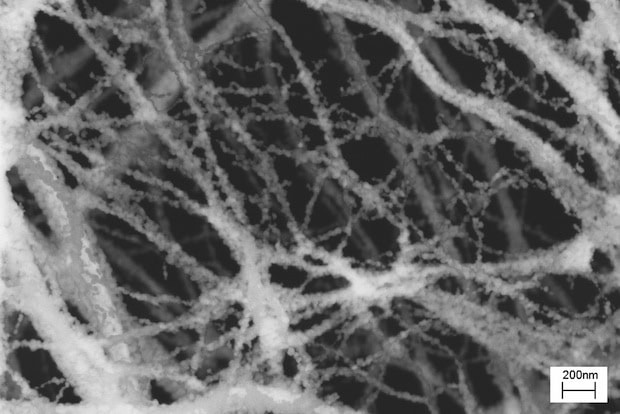
[Image above] Self-supporting ceramic nanogrid photocatalysts (SEM image) may one day make scenes like this one, showing deployment of a containment boom at Pensacola, Fla., after the 2010 Deepwater Horizon oil spill, a thing of the past. Credit: P. Gouma/SUNY
We’ve all seen video of cleanup efforts resulting from oil spills large and small, from the Gulf of Mexico to local streams. Typically, cleanup involves a painstaking “mop-up” process followed by weeks or months of rehab by armies of paid employees and volunteers to repair damage to the environment.
A new product from the laboratory of a ceramic scientist and currently being readied for production by a startup company could make cleanup as simple as throwing a net over the offending oil slick. Pelagia-Irene (Perena) Gouma, professor of materials science and engineering at State University of New York Stony Brook, led a team that created a novel copper tungsten oxide nanogrid photocatalyst. Activated by sunlight, the net breaks down spilled oil, leaving behind only biodegradable compounds.
“[This] is the first time that self-supported nanostructured catalysts have been shown to clean up petroleum-based hydrocarbons in water,” Gouma writes via email. “Our technology responds to visible light (as opposed to the UV-responding industrial catalysts), it does not rely on dispersed and loose nanostructures that need to be confined or retrieved after a cleaning step, and as an oxide catalytic system it is reusable and not consumed during use. The products of the hydrocarbons clean up/water remediation are innocuous and biofriendly.”
Gouma, director of SUNY’s Center for Nanomaterials and Sensor Development, says in a National Science Foundation news release that the invention “utilizes the whole solar spectrum and can work in water for a long time, which no existing photocatalyst can do now. Ours is a unique technology. When you shine light on these grids, they begin to work and can be used over and over again.” Ships could carry the nanogrid nets, and so be able to handle their own small spills, she adds.
According to Gouma, the self-assembling nanogrids form in a multistep process that involves a combination of templating and blend electrospinning. “Upon heating, metal clusters diffuse inside polymeric nanofibers, then turn into single-crystal nanowires, then oxidize to form metal oxide—ceramic—nanoparticles that are interconnected, like links in a chain,” she says in the news release.
Gouma envisions the nanogrid photocatalyst materials being used not only to clean up oil spills but to break down other environmental contaminants, such as water used in hydrofracturing extraction of natural gas. Applications exist for more mundane applications, too, such as, for example, at-home dry cleaning. “The dry cleaning process that we now use involves a lot of contaminants that have to be remediated and treated, such as benzene,” she says in the news release. “This could be a dry cleaning substitute that would be more environmentally friendly than current dry cleaning approaches.”
She imagines users simply laying the nanogrid over articles of clothing and exposing them to light to clean them. “You won’t need a washing machine, or chemicals, or even water,” she says.
Gouma and her team have two patents pending on the nanogrid technology and have launched a startup company to commercialize production. “We are focusing on scaling up further the nanomanufacturing process while optimizing the nanogrids’ composition and properties,” she writes via email. “[The nanogrids] are currently being produced in sheets several inches wide that can be directly applied to (and be recovered from) an oil spill in water.”
This is not the first time Gouma, an ACerS member since 1997 and recent winner of the Society’s Richard M. Fulrath Award, has made news on Ceramic Tech Today. Her work developing nanosensors for disease diagnosis has been featured both here and in the September 2012 ACerS Bulletin.
Author
Jim Destfani
CTT Categories
- Environment
- Nanomaterials


